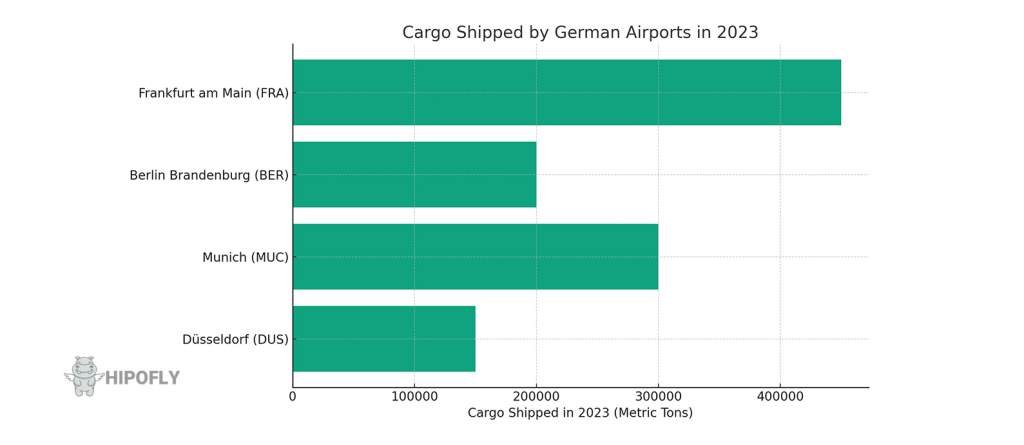Introduction
Major Cargo airports in Germany
In the world of international shipping from China to Germany and neighboring countries, a deep understanding of Germany’s major cargo airports is essential. Among them, Frankfurt Airport reigns as a colossal gateway. As Germany’s largest and one of Europe’s busiest cargo airports, it plays a central role in facilitating the flow of goods, particularly in international trade between China, Germany, and nearby nations.
Leipzig/Halle Airport is another key player, ranking as Europe’s fifth-largest cargo airport. Its strategic central location makes it a crucial hub for air freight connections between China, Germany, and the surrounding regions. Meanwhile, Cologne Bonn Airport, located in North Rhine-Westphalia, serves as a critical transportation hub for the efficient movement of goods in and out of Germany and its neighboring countries.
Munich Airport, primarily a passenger-focused airport, also contributes significantly to cargo operations in southern Germany, while Hamburg Airport in the north steadily expands its cargo capabilities. These airports collectively ensure the smooth flow of goods and strengthen Germany’s role in global trade.

Here is a list of the major international cargo airports in Germany:
Frankfurt am Main Airport (FRA)
The Frankfurt Airport is southwest of the city, and the transportation company Fraport runs it. Frankfurt Airport is one of the busiest in Europe. It’s not easy to find your way around the airport.
Every year, more than 2.3 million tonnes of freight are moved through Frankfurt Airport. This makes FRA the most important place for moving goods in Europe and one of the most important places for moving people in Europe. Frankfurt is linked to 357 places in 105 countries by more than 130 passenger and cargo airlines (2021). We have the best “Total Hub Connectivity” in Europe because of this (ACI 2022).
This is where more freight forwarders are based than anywhere else in Europe. This makes Frankfurt a great place for airlines to stop. One reason for this is that the airport is right in the middle of Europe. All of Europe can get to the airport by truck in just 18 hours, and it is right next to the busiest highway interchange in Europe. This perfect link between the air and the road is one of a kind.
Southwest of Frankfurt, the airport is right next to the A3 highway. Wiesbaden, Darmstadt, and Mainz are also close to the airport.
Terminal 1 (A, B, C, and Z) and Terminal 2 make up the airport (D, E). Level 0 is the Airport City Mall, Level 1 is Arrivals, Level 2 is Departures (T1A, T1B, and T1C), and Level 3 is also Departures (T1Z). There are four runways at the airport, and the new Terminal 3 will open in 2022. You can use the APM or a shuttle bus to get from one terminal to another.
| Information | Value |
|---|---|
| IATA | FRA |
| ICAO | EDDF |
| City | Frankfurt am Main |
| Elevation | 364 ft (111 m) |
| Runways | 4 |
| Longest runway | 13,123 ft (4,000 m) |
| Airlines | 100 |
| Destinations | 239 |
| Passengers | 24,812,849 |
| Cargo | 2,091,174 tons |
| Movements | 513,912 |
Airport Berlin Brandenburg (BER)
The Berlin Brandenburg Airport (BER) represents a groundbreaking development in European aviation, formally commencing operations in the autumn of 2020. It marked the transition away from Berlin’s legacy airports, Tegel and Schonefeld, consolidating air traffic operations into a single, modern facility. BER, located 18 kilometers southeast of Berlin’s city center, bears the name of Willy Brandt, a prominent figure who served as both Berlin’s mayor and the German chancellor. Notably, the new airport incorporated some of Schonefeld’s existing infrastructure, including an extended and modernized runway.
At the heart of the airport’s cargo operations lies the Cargo Center, strategically positioned in the Service Area North, adjacent to Terminals 1 and 2. This specialized facility is dedicated to handling cargo transported in the belly of passenger planes, offering swift and efficient services. Encompassing an impressive 12,000 square meters, the Cargo Center boasts the capacity to manage approximately 100,000 tonnes of belly cargo annually, with cargo services managed by two reputable companies, Wisag Cargo Service (WSC) and Swissport Cargo Service (SCS).
The Express Center, covering a 4,000-square-meter space in the northern part of BER, is where FedEx and UPS oversee their express services. Beyond these services, the German Red Cross (DRK) utilizes the space to store mobile hospitals that can be rapidly deployed for emergency relief efforts worldwide. This facility handles approximately 30,000 tonnes of air freight annually. The expansion of this essential cargo hub has been notably driven by the growth of cargo airlines, particularly UPS and FedEx, with growth rates currently hovering around 10%. BER, with its array of terminals and efficient transportation connections to the city center, stands as a pivotal hub for both passenger and cargo services, bolstering Berlin’s position in the global aviation landscape.
| Information | Value |
|---|---|
| IATA | BER |
| ICAO | EDDB |
| City | Berlin |
| Elevation | 156 ft (48 m) |
| Runways | 2 |
| Longest runway | 13,123 ft (4,000 m) |
| Airlines | 97 |
| Destinations | 170 |
Munich Airport (MUC)
Munich Airport is the second busiest airport in the country. It has Terminal 1 (Gates A–E), Terminal 2 (Gates H–I), Satellite Terminal 2 (Gates K–L), and the München Airport Center (MAC). Lufthansa and Eurowings use the airport in Bavaria, also called Franz Josef Strauss Airport, a lot. The only airport in the world with its own brewery, Airbrau, is Munich Airport.
The airport is northeast of Munich, which is the capital of the German state of Bavaria. It is close to the town of Freising. By car, it’s easy to get to Munich Airport. From the south, take exit 6 (Flughafen München), and from the north, take exit 7 (Freising-Mitte).
Munich Airport has three terminals: Terminal 1, Terminal 2, and Satellite Terminal 2. Terminal 2 is used by Lufthansa and Star Alliance members. Terminal 2 and Satellite Terminal 2 are owned by both Lufthansa and Munich Airport.
Cargo Facilities:
- Cargo terminal
- Gross floor area: 115,000 sqm
- Floor space of cargo terminal: 53,000 sqm
- Parking positions for 7 B747-400F or 14 smaller aircraft
- Freight Forwarders Building, 1st and 2nd module
- Area of 32.000 sqm
- Transshipment capacity of 530.000 tons a year
- Border Inspection Post & Animal Station
- Floor area: 1,500 sqm
- Separate handling areas for human consumption, non human consumption and live small animals
- Can be expanded into a Perishable Centre in a modular manner
- Express Center
- Area: 4,400 sqm
- Facility to be used exclusively by DHL, FedEx and UPS
Düsseldorf Airport (DUS)
Dusseldorf Airport Cargo handles more than 114,000 tonnes of cargo every year. To meet the growing needs of the pharmaceutical industry, the company has spent €3 million on a new temperature-controlled warehouse.
The company is owned by Düsseldorf Airport 100 percent, and it plans to be one of the first cargo companies to get IATA’s (International Air Transport Association) accreditation for the special handling of pharmaceutical products. It hopes to reach this goal by the beginning of 2016.
German airlines Eurowings, Condor, TUI, and fly Deutschland all use this airport as a hub. In 2019, 25.5 million people will use the airport, making it one of the 25 busiest in Europe. There is a train station (Düsseldorf Flughafen) and a subway station (Düsseldorf Flughafen Terminal/S-Bahnhof) at Düsseldorf Airport.
The airport is north of Düsseldorf and to the east of the Rhine River. By car, you can get to the airport from the A44 at exit 31 Flughafen Düsseldorf.
There are three terminals at the airport: A, B, and C. They are all in the main airport building. The SkyTrain monorail connects the landside of Terminal A/B and Terminal C with car park P4/P5 and the Düsseldorf Flughafen train station. The SkyTrain is a fully automated cabin train that runs above the airport. It’s a lot of fun, especially for little kids.
| Information | Value |
|---|---|
| IATA | DUS |
| ICAO | EDDL |
| City | Dusseldorf |
| Elevation | 147 ft (45 m) |
| Runways | 2 |
| Longest runway | 9,842 ft (3,000 m) |
| Airlines | 57 |
| Destinations | 147 |
Other Airports in Germany
- Berlin-Tegel Airport
- Hamburg Airport
- Stuttgart Airport
- Cologne Bonn Airport
- Hannover Airport
- Berlin-Schönefeld Airport
- Nuremberg Airport
- Leipzig/Halle Airport
- Bremen Airport
- Dresden Airport
- Dortmund Airport
- Karlsruhe Baden-Baden Airport
- Münster Osnabrück Airport
- Memmingen Allgau Airport
- Friedrichshafen Airport
- Saarbrücken Airport
- Paderborn Lippstadt Airport
- Westerland Sylt Airport
- Rostock-Laage Airport
- Frankfurt-Hahn Airport
- Lübeck Blankensee Airport
- Kassel-Calden Airport
- Heringsdorf Airport
- Erfurt Airport
- Mannheim-City Airport
- Weeze Airport
Conclusion
In summary, Germany boasts a network of major cargo airports that play a pivotal role in facilitating the efficient movement of goods, not only within the country but also in international trade, particularly with China and neighboring nations. These airports handle substantial cargo volumes annually, contributing significantly to Germany’s prominence in global trade. Frankfurt Airport, Leipzig/Halle Airport, Cologne Bonn Airport, Munich Airport, and Hamburg Airport collectively ensure the seamless flow of goods, thanks to their strategic locations, modern facilities, and efficient transportation connections. Whether it’s pharmaceuticals, general cargo, or express services, these airports cater to diverse industries and international trade routes, making them vital components of Germany’s cargo logistics network.
For international shipping from China to Germany or neighboring countries, we recommend visiting our dedicated page.
FAQ
Germany's major cargo airports feature advanced logistics infrastructure, extensive cargo handling facilities, and strategic locations for efficient distribution of goods across Europe.
German cargo airports are equipped with modern facilities and technology to efficiently manage and process a large volume of international trade goods, ensuring timely and secure delivery.
They implement stringent security measures, including advanced surveillance and screening processes, to ensure the safety and integrity of imported goods.
German cargo airports utilize state-of-the-art technologies like automated handling systems, real-time tracking, and efficient logistics software to enhance operational efficiency.


